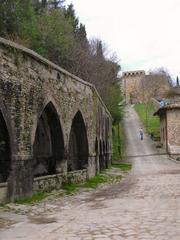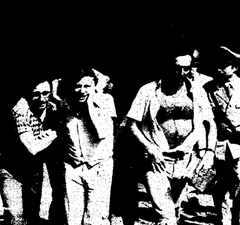Aiano-Torraccia di Chiusi Roman Villa: Visiting Hours, Tickets, and Historical Site Guide – San Gimignano, Italy
Date: 03/07/2025
Introduction
The Aiano-Torraccia di Chiusi Roman Villa, situated near the medieval towers of San Gimignano in Tuscany’s Siena province, is a remarkable archaeological site that reveals the evolution of rural aristocratic life from the late Roman Empire into the early Middle Ages. Founded in the late 3rd or early 4th century CE, the villa transitioned from a lavish country estate into a dynamic center for artisanal and industrial activity. This transformation reflects not only the shifting economic and cultural dynamics of Central Italy, but also the resilience of its rural communities during periods of upheaval (core.ac.uk; academia.edu).
Strategically located near ancient routes like the via Romea and, later, the Via Francigena pilgrimage path, the villa exemplifies the intersection of social status, economic innovation, and regional connectivity in Roman and post-Roman Tuscany (Comune di San Gimignano; Musei Senesi). Since 2005, collaborative excavations by the Université catholique de Louvain and the University of Florence have unearthed exceptional architectural features—such as a rare six-foiled monumental hall and intricate mosaics—alongside ceramics, glass, and metalwork, which together document the villa’s adaptation from elite residence to productive workshop (springer.com; uclouvain.be).
This guide presents an in-depth overview of the site’s historical significance, architectural evolution, visitor information, and its role within the broader context of Tuscan heritage.
Table of Contents
- Discovering the Roman Villa at Aiano-Torraccia di Chiusi
- Practical Visitor Information
- The Villa in the Context of Roman and Etruscan Tuscany
- Conservation, Research, and Future Directions
- References
Discovering the Roman Villa at Aiano-Torraccia di Chiusi
Origins and Historical Development
The villa was established in the late 3rd or early 4th century CE, at a time when the fertile lands of Val d’Elsa supported prosperous agricultural estates. Its initial phase was marked by opulence: spacious residential quarters, private baths, and decorative mosaics, all attesting to the wealth and social standing of its owners (core.ac.uk).
Transformation and Post-Roman Occupation
As the Western Roman Empire declined (5th–7th centuries CE), the villa adapted to changing conditions. Elite living spaces gave way to workshops specializing in ceramics and glass, signaling economic diversification in response to broader political and social changes (academia.edu). In the 6th and 7th centuries, Ostrogothic and Lombardic artisans further developed these productive activities, as reflected in the abundance of ceramics—coarse wares, red slip pottery, and distinctive local “ingobbiate” wares—attesting to cultural blending and economic resilience (springer.com).
Archaeological Discoveries
Excavations led by the Université catholique de Louvain and the University of Florence have unearthed thousands of artifacts, ranging from ceramics to glass and metal objects. Analyses reveal both technological sophistication and extensive trade connections. Notable finds include:
- Simil africane: Fine wares inspired by North African pottery
- Ingobbiate: Local red-covered ceramics from later periods
- Acrome grezze: Everyday coarse pottery
These finds provide a window into the villa’s economic and cultural transformations and highlight its importance within the region.
Practical Visitor Information
Visiting Hours and Tickets
- Open: Tuesday–Sunday, 9:00 AM–5:00 PM; closed Mondays and select holidays
- Tickets: €8 adults, €5 for students/seniors, free for children under 12
- Booking: Tickets can be purchased onsite or in advance via the San Gimignano tourism website
- Guided Tours: Available weekends at 10:00 AM and 3:00 PM or by appointment
Accessibility
- Wheelchair access: Designated paths and assistance available in main areas; advance arrangement recommended
- Site terrain: Uneven in places—wear sturdy shoes
Visitor Tips
- Best time to visit: Spring and autumn for comfortable weather
- Facilities: Limited; bring water and sun protection
- Photography: Permitted in most areas
Getting There
The villa is accessible by car or public transport from Siena and San Gimignano. Detailed directions are available on the official website.
Nearby Attractions
- San Gimignano: Famed for its medieval towers and UNESCO status
- Elsa Valley: Rich in Roman and medieval sites
FAQs
What are the opening hours?
Tuesday–Sunday, 9:00 AM–5:00 PM
Are guided tours available?
Yes, on weekends and by request
Is the villa accessible for visitors with disabilities?
Yes, with accessible paths and assistance available
How do I get there?
By car or public transport; see the official website for details
Are there other attractions nearby?
Yes, including San Gimignano and the Elsa Valley
The Villa in the Context of Roman and Etruscan Tuscany
Geographical Setting
The villa occupies a narrow plateau above the Foci stream, a tributary of the Elsa River, near the crossroads of ancient Roman territories including Siena, Volterra, and Florence (Academia.edu; Comune di San Gimignano). The region’s history as a corridor between the Tyrrhenian coast and the Arno Valley is reflected in both Etruscan and Roman settlement patterns (Musei Senesi).
Architectural Evolution
The villa’s plan, partially excavated over an area of 1,750–3,000 m² (with geophysical surveys suggesting up to 10,000 m²), features a monumental six-foiled hall, residential quarters, and agricultural annexes (Academia.edu). By the 6th century, much of its decorative material was recycled, and workshops replaced elite domestic spaces (Academia.edu).
Regional Networks and Continuity
Proximity to major routes like the Via Francigena highlights the villa’s role within economic and social networks. Its evolution mirrors broader trends in late-antique Tuscany, where many villas shifted from elite residential centers to production hubs (Academia.edu).
Material culture—from ceramics to glass and metalwork—shows both continuity and innovation, reflecting the villa’s enduring significance through the Etruscan, Roman, and early medieval periods (Musei Senesi; Comune di San Gimignano).
Key Facts Table
| Aspect | Details |
|---|---|
| Location | Near San Gimignano, Siena province, Tuscany |
| Chronology | 4th–7th/8th centuries CE (Roman to Early Medieval) |
| Excavated Area | 1,750–3,000 m² (estimated total 10,000 m²) |
| Functions | Elite residence, agricultural estate, later artisanal/industrial center |
| Notable Features | Mosaic floors, wall paintings, workshops for metal, glass, and pottery |
| Etruscan Context | Region with Etruscan settlements and necropolises; continuity in land use |
| Roman Context | Part of VII regio; near major Roman and medieval routes (Via Francigena) |
| Transformation | Shift from residential to productive use; gradual abandonment in Early Middle Ages |
| Archaeological Significance | Key site for rural elite life, economic change, and cultural continuity |
Conservation, Research, and Future Directions
Ongoing excavation campaigns, conservation of mosaics and wall paintings, and the implementation of digital documentation methods ensure the villa’s legacy is preserved for future generations. Current projects aim to expand research, improve visitor facilities, and integrate the villa into broader cultural tourism networks (uclouvain.be).
Visual Resources
Virtual tours, interactive maps, and high-resolution images are available on the official project website.
References
- Discovering the Roman Villa at Aiano-Torraccia di Chiusi: A Journey Through Time in Siena (core.ac.uk)
- Late Antique Roman Villas in Central Italy Compared: Settlement Patterns, the Aiano-Torraccia di Chiusi Case (academia.edu)
- Aiano-Torraccia di Chiusi: Ceramic Production and Cultural Continuity (springer.com)
- The Villa of Aiano-Torraccia di Chiusi in the Context of Roman and Etruscan Tuscany (Academia.edu)
- Comune di San Gimignano: Villa Romana di Aiano-Torraccia di Chiusi (Comune di San Gimignano)
- Musei Senesi: La Villa Romana di Aiano-Torraccia di Chiusi (Musei Senesi)
- UCLouvain Project: La Villa Romaine d’Aiano (uclouvain.be)
- Siena Tourism Official Website (San Gimignano Tourism)
Plan Your Visit
For the latest updates on visiting hours, guided tours, and ongoing research, consult the official project website or the San Gimignano tourism portal. Download the Audiala app for immersive audio guides, and follow official social media channels for event announcements and travel tips.



